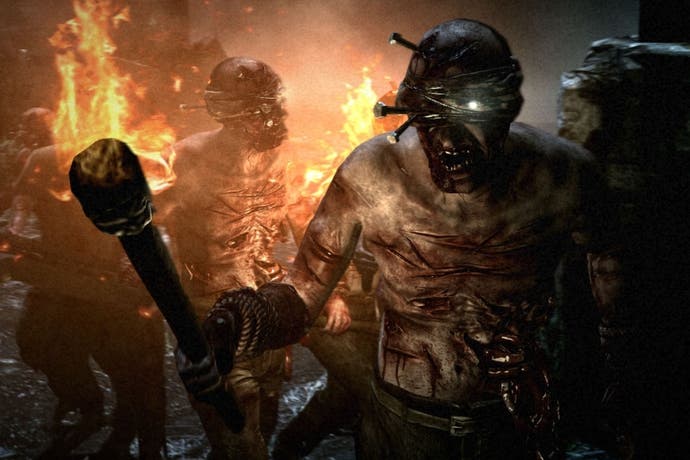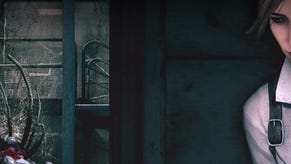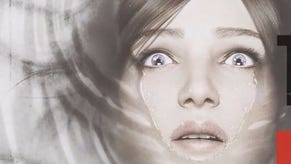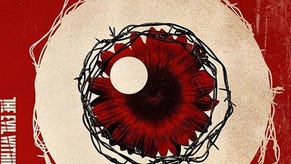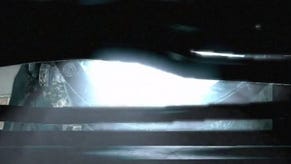Can I play with madness? The Evil Within and the return of survival horror
“You will be running. A lot.”
Survival horror is a genre in crisis. Its most surprising jolts have become clichés, its core elements have been compromised by the inexorable march towards AAA action. Where once players would fire every bullet reluctantly, conscious that each shot wasted might be the difference between life and death minutes later, now our horror heroes march into battle with customised machine guns, mowing down the monsters with impugnity.
The Evil Within aims to reset the genre compass. How much of the game will be spent running, and how much will be spent fighting? "You'll be running. A lot," deadpans the game's US producer, Jason Bergman. "The emphasis is on scaring the hell out of you."
We're watching Bergman play his way through an early build of The Evil Within while seated in the appropriately gothic library of the Elvetham estate in Hampshire, bathed in blood red lighting. It's a 19th Century mansion, itself built on grounds that date back to the 1400s. Portraits of long dead patriarchs stare down from beneath vaulted ceilings, while stairs and passageways cut through the stark stone architecture in odd ways. Throw in a couple of shuffling blue-faced zombies in the restaurant and this could be yet another mansion atop another secret Umbrella Corp lab. It feels appropriate.
The Evil Within is Shinji Mikami's attempt to salvage the genre he helped to create back in 1996 with Resident Evil. After overseeing Resident Evil 4 at Capcom, Mikami has spent the last decade working on eclectic offerings such as the gonzo fighting game God Hand, slick Sega shooter Vanquish and collaborating with Suda51 on the grindhouse shlocker Shadows of the Damned. Now, for what will reportedly be his last game as director, he's bringing scary back.

The first section we see comes from the very start of the game. Our detective hero, Sebastian, is responding to an emergency at a mental hospital. Police cars are abandoned outside, and all the weapons are missing. He tells his female partner she's not coming inside. "Pulling rank?" she asks. "Just watch the door," he snaps. Sebastian seems like an arsehole, and the fact that he's wearing a 1940s private eye trenchcoat without a hint of irony doesn't help.
It may be that there's a narrative reason for making Sebastian act like such a chauvinistic git, but in gameplay terms it's much simpler. "There are other people with you, but it's not a co-op experience," Bergman says, reassuringly. "The emphasis of the game is very much on Sebastian's character and Sebastian's survival. You won't have to worry about escort missions or anything like that. It's a very directed survival horror experience."
Speaking of which, here comes the horror. "That smell!" Sebastian mutters as he ventures inside the hospital, where gore has already been smeared all over the floors and walls. "Ugh, it smells like blood!" he gasps. As quotable dialogue goes, it's no "master of unlocking" but it's close. As with so many survival horror games, it's hard to tell if it's this corny on purpose, or if this is yet another example of what happens when western pulp horror gets filtered through a Japanese prism. Either way, this is definitely a Shinji Mikami game.
Sebastian finds a bloodied survivor, apparently one of the hospital's doctors. "It was him," the man intones. "It couldn't be." There's a sudden attack and Sebastian is knocked out. When he comes round, he's hanging upside down from a meathook. A masked brute casually saunters past and begins hacking up a corpse. As the butcher wanders back to his bench with whatever meaty prize he's claimed, player control returns. Swinging to retrieve a knife embedded in another hanging body, you cut yourself free and enter a stealthy escape sequence.
Two things are immediately clear. Despite his tin ear for dialogue, Mikami still knows how to stage tension. The sequence that follows has a pitch perfect ebb and flow, from a nail-biting attempt to steal the keys needed for escape, to a panicked chase through hospital corridors strewn with gurneys and other obstacles, then back to a tense waiting game as Sebastian hides in a locker and watches as his chainsaw-wielding pursuer tears the room apart looking for him. Then it's back out into the corridors, where the chase ramps up again. Whether creeping, scrambling or diving for the safety of an elevator, the chainsaw striking sparks as it misses Sebastian's exposed back, it's all expertly, breathlessly choreographed.
The second thing that is apparent is how nice this game looks, or at least as nice as a game knee deep in viscera can be. The butcher manages to take a slice out of Sebastian's leg, causing him to limp and stumble. It's a familiar mechanic, dating back to Resident Evil 2, but the animation is superb and really sells that nightmarish panic of needing to move faster than you're physically able. The lighting is also stunning, and small details like the movement of curtains and cloth all feel very real. It's a seriously nice looking game, presented in a cinematic 2.35:1 ratio, and running on a version of id Tech 5 that Mikami's Tango Gameworks studio has modified specifically for this game.
It's the high end PC version that is being demoed, of course, so adjust your technical expectations accordingly. "This isn't really the current gen console version. It's definitely not the next gen version," Bethesda's Pete Hines explains. "It's sort of in between there somewhere."
Sebastian finally finds a way out of the hospital, only to discover that the world outside has been utterly destroyed. The ruined city stretches into the distance, all chasms and crumbling skyscrapers. It's a nice apocalyptic note in a genre that generally keeps its plot developments at a more personal level.
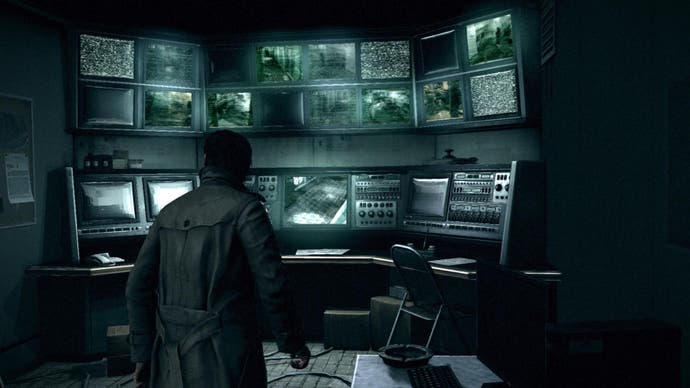
What is noticeable is that everything we've just seen has been incredibly linear, essentially a long chase sequence with no apparent room to deviate from the path. "The game tends to be divided into two separate sections," Bergman explains. "There are horror areas and exploration areas. The exploration areas emphasise the survival aspect of going around to every possible area and trying to gather as much health and items as possible. Those are much more open. The horror areas are very, very confined and a little more linear."
By way of illustration, the demo now shifts to later in the game, and what appears to be an old timber-framed house where Sebastian explores the ground floor and cellar for ammo and health syringes. It's in the murky cellar that we get our first glimpse at what is presumably the game's basic enemy. Pitched somewhere between zombies, the shambling fleshbags of Silent Hill and the body modified Cenobites of Hellraiser, the method by which you dispatch them is comfortingly familiar: shoot them in the head. The smart player, however, knocks them over and sets them alight with matches to save ammo. "Scarcity of resources is a big theme of the game," says Hines. "You're not going to find yourself with a gun and lots and lots of ammo."
Back upstairs, more monsters start to approach the building. As they mass outside, forming a mob that advances up towards the house with murderous intent, it's hard not to be reminded of Resident Evil 4's Los Ganados. Sebastian is able to lay traps to keep the creatures at bay, placing them in front of the windows to finish off anything that clambers over the sill. Sadly, we don't get to actually see what sort of effect the traps have. Even though we hear them going off, Bergman is now visibly struggling to keep Sebastian alive as the enemies swarm in.
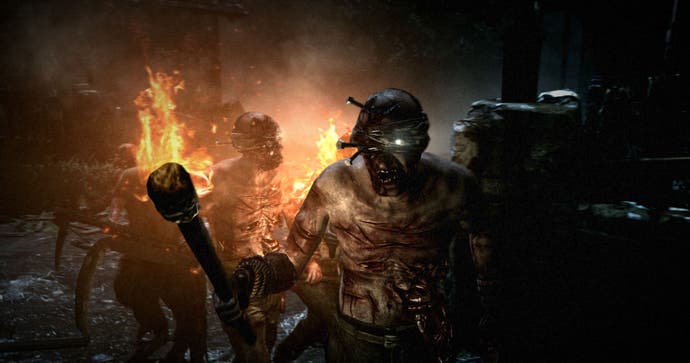
Overwhelmed, he runs downstairs and things get weird. The cellar is now replaced with grey concrete corridor where previously you couldn't get through. This is another of the game's selling points, apparently: a game world that changes and shifts in real time. Hallucination? Parallel dimension? There's no time to contemplate the mystery, as the demo ends with a tease of a boss fight against a squelchy, screeching thing that looks like a cross between Left 4 Dead's witch and a giant crab.
And there the demo ends. It's certainly as pure as survival horror gets, with an emphasis on keeping the player vulnerable and outmatched, plus the obligatory side order of confusing mind games and grisly gross stuff. For fans who have been left unsatisfied by recent entries in the Resident Evil and Silent Hill franchises, this definitely seems like it'll tick all the right boxes.
It would be good to see some hint that there's more to The Evil Within than what's being shown, however. When Mikami made his name with Resident Evil, he did so not by giving players something they expected, but something they didn't. The Evil Within, by contrast, seems to be designed to give players exactly what they want. With the grass roots success of minimalist games like Amnesia and Slender, it just feels that the cutting edge of horror gaming has moved on from the template so lovingly being revived here. If this is truly to be Mikami's final game as director, it would be nice if he could leave horror gaming with a truly terrifying new benchmark to aspire to, not one last victory lap inspired by past glories.
